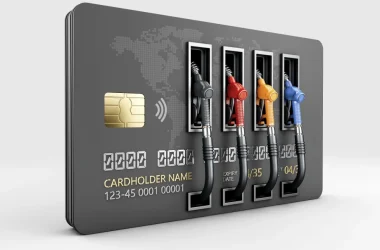Fuel costs can be a real headache for businesses, especially those that rely on fleets for daily operations. Every time fuel prices rise, it feels like your budget goes into freefall. But what if there was a way to take control of these expenses and actually start saving money? Enter fuel cards—those seemingly simple pieces of plastic can unlock a whole world of helpful information. They provide valuable insights into spending patterns, helping fleet managers make smart decisions that cut costs and boost efficiency. Let’s dive into the nuts and bolts of how fuel cards work and why they are essential for modern fleet management.
Fuel cards provide essential data such as transaction histories, vehicle-specific fuel usage, and real-time reporting on fuel spending. By analyzing this information, fleet managers can identify inefficiencies, optimize routes, and implement spending controls to effectively reduce overall fuel costs.
The Role of Fuel Cards in Fleet Management
Fuel cards have truly revolutionized the way businesses handle their vehicle expenses by offering a payment method that goes far beyond simple purchasing. For fleet managers, these cards act as an essential tool for tracking fuel expenditures and gathering crucial data. This means that with every transaction, not only is fuel being purchased, but vital insights are also being recorded about vehicle performance and operational efficiency.
When integrated effectively into fleet operations, fuel cards can help identify trends in fuel consumption, pinpointing which vehicles may need maintenance or adjustments to improve fuel efficiency. It’s like having a digital dashboard of your fleet’s health at your fingertips. For instance, if one vehicle routinely uses more fuel than its counterparts, it raises a red flag and indicates that preventative maintenance or even driver re-training might be necessary—saving the company money in the long run.
In essence, a fuel card serves two primary purposes: it acts as a payment method for gas while simultaneously providing the analytical tools needed for running a successful fleet. This comprehensive approach allows businesses to leverage data analytics to optimize routing and scheduling—which significantly impacts fuel expenditure.
Consider this: typically experience up to 20% savings on fuel costs due to discounts and rebates associated with bulk purchases. That’s quite an enticing figure when you think about the cumulative effect over time across multiple vehicles.
With features like spending controls and real-time transaction data, fleet managers can keep a close watch on budgets without relying on time-consuming paper receipts and delayed expense reports.
The security elements of fuel card technology should not be overlooked either. More sophisticated than traditional magnetic strip cards, modern cards often come equipped with smartchip technology that offers customizable transaction limits based on specific needs. This ensures control over sensitive purchasing transactions and reduces the risk of fraud—an important consideration for managers concerned about unauthorized spending.
All these features contribute to a more streamlined process for managing not just fuel purchases but also the entire operational workflow of a fleet. As companies increasingly recognize the value of innovative solutions like these, they also stand ready to discover further insights into how such tools function effectively.
How Fuel Cards Work
Fuel cards, often referred to as fleet cards, are designed to streamline fuel purchasing and management within a business. The process starts with companies like issuing fuel cards that can be linked to specific drivers or vehicles in a fleet. Each fuel card connects to an account within the company’s broader fleet management system, allowing for straightforward allocation based on individual vehicle needs. This initial step is vital because it sets the foundation for efficient tracking and accountability across the entire fleet.
Step I – Issuing Fuel Cards
When a company decides to implement fuel cards, they typically request these from providers such as Shell or WEXcard. The assigned cards are crucial tools that simplify monitoring by associating each driver’s purchase behavior with their vehicle’s performance. For instance, by linking each driver’s fuel card directly to a predetermined budget, managers gain defined spending limits while promoting responsible usage. This setup not only enhances control but also fosters awareness among drivers regarding fuel efficiency and costs.
Step II – Using the Fuel Card
Once the cards are issued, drivers can utilize them seamlessly at participating fuel stations. As they swipe their cards at the pump, each transaction is recorded in real-time, providing invaluable data points such as how much fuel was purchased, the price per gallon, and which location was used for the refueling process.
This feature eliminates the mess of collecting paper receipts, saving significant administrative time managing invoices later on. Immediate access to this information allows businesses to promptly address discrepancies—like spotting unusually high expenditure or inconsistencies in fueling behaviors—that may arise due to human error or potential fraud.
Step III – Integrating with Fleet Management Systems
After transactions are made, the next logical step is integrating this data into fleet management systems. This integration allows businesses to have an overarching perspective of their operational expenses, driver habits, and overall fuel consumption trends over time. Companies can generate reports highlighting inefficiencies or instances of non-compliance with spending policies that require managerial attention.
By centralizing transaction data into one accessible location, fleet managers can respond proactively to emerging issues—this amalgamation of data signals drivers who might need additional training on fuel-efficient driving techniques or highlights ideal refueling practices.
With a solid understanding of how fuel cards facilitate purchasing processes and enhance management visibility, we can now shift our focus to the types of critical information these cards capture and its implications for boosting efficiency in operations.
Key Data Tracked by Fuel Cards
Fuel cards do more than just serve as a convenient payment method; they act as powerful tools that gather vital data for businesses. One of the most significant aspects is tracking fuel consumption and costs. Each time a transaction occurs, details such as the volume of fuel purchased, cost per gallon, and total expense are meticulously recorded. With this wealth of information at their fingertips, fleet managers can analyze spending patterns, pinpoint inefficiencies, and make informed decisions to slash unnecessary costs. Imagine sifting through your expenses not just to know how much you spent but to realize where you can save over time.
Driver Behavior
Beyond fuel metrics, driver behavior is another crucial area monitored via fuel cards. They provide insights into where fuel is purchased, allowing businesses to establish a trend for each driver. Any irregular activities—such as multiple refuels within brief periods or filling up at unusual times—can signal potential misuse or concern. Moreover, when linked with telematics systems, these cards can reveal how drivers operate vehicles; behaviors like excessive idling, speeding, and harsh braking get flagged instantly. Recognizing these patterns helps fleet managers coach their drivers towards more economical driving habits.
Route Optimization
Additionally, combining fuel card data with GPS tracking takes fleet efficiency up a notch through route optimization. By analyzing the routes taken against the amount of fuel consumed, fleet managers can identify longer routes that unnecessarily contribute to high operational costs. Optimizing these routes—possibly suggesting alternative paths—means businesses can save on fuel and enhance delivery times. Saving time and money simultaneously is a win-win situation that every fleet manager strives to achieve.
Equipped with insights from this data, it’s essential for fleet managers to explore effective analysis techniques that will harness its power in reducing overall fuel expenses.
Analyzing Data to Cut Fuel Costs
Data without analysis is just numbers, but when you uncover insights within that data, it transforms into a treasure trove. Start by identifying high-fuel consumption vehicles in your fleet. This isn’t solely about tracking the obvious; it’s about pinpointing vehicles with consistently higher consumption rates than their peers.
When you find these culprits, schedule maintenance checks. Often, poor engine performance or neglected upkeep drains fuel efficiency, leading to unnecessary costs. Imagine feeling satisfied knowing you eliminated a significant drain on your budget just by keeping an eye on maintenance!
Once you’ve addressed these vehicle inefficiencies, shift your focus to another crucial aspect: driver behavior.
By monitoring and adjusting how your drivers behave behind the wheel, you’re opening the door to further savings. With fuel card data at your disposal, examine aspects like idling time—an often-overlooked factor. Encouraging drivers to switch off the engine while waiting can lead to surprising reductions in fuel consumption.
It may seem minute, but if a vehicle idles for just 20 minutes a day, that can add up to roughly an entire tank of gas each month! Training programs that emphasize efficient driving not only save costs but also enhance the overall safety of your fleet.
As you hone in on driver habits, consider another powerful optimization—routing.
Using data-driven insights to optimize routes is one of the most impactful steps available. Imagine analyzing routes and realizing that avoiding congested areas could significantly reduce stop-and-go driving, saving fuel in the long run.
Employ software that integrates your fuel card data with live traffic updates and reroute vehicles in real-time. This approach leads to more efficient journeys and reduces wear and tear on your vehicles. Think of the peace of mind knowing that every trip counts and contributes positively to your bottom line.
After understanding these analytical dimensions, the next step is making an informed choice about selecting the right system tailored to meet your specific needs.
Choosing a Fuel Card System
Not all fuel card systems are created equal, and recognizing the distinguishing features can make all the difference in managing your fleet efficiently. Let’s take a closer look at the key aspects you should consider before making your decision.
First up is coverage. When assessing coverage, think about where your vehicles typically operate and how many stations are available in those areas. It’s not enough to have a fuel card that works at a couple of stations near your headquarters; having broad acceptance ensures that your drivers won’t waste time searching for compatible stations during long hauls.
Many fleet managers often overlook this aspect until they find themselves limping along with limited fueling options in more remote locations.
Next is data integration, which is essential for modern fleet management. A good fuel card system should seamlessly integrate with your existing fleet management software. This integration allows for real-time data analysis and comprehensive oversight of fuel consumption at any moment, helping to identify trends or issues as they arise. By centralizing this information, you reduce the chances of errors and make informed decisions swiftly.
Now let’s pivot to security features that protect both your finances and your assets.
Security cannot be understated when evaluating fuel cards. Measures like PIN protection and fraud monitoring play a crucial role in safeguarding against unauthorized transactions. With increasing cases of fraud, it’s reassuring to know that your transactions are monitored and protected. Don’t hesitate to ask potential providers about their security measures—this knowledge will offer peace of mind as you manage sensitive financial data.
The reporting capabilities of a fuel card system profoundly affect how effectively you manage operational expenses. Look for systems that generate detailed reports on fuel purchases, including date, time, location, and amounts spent. These reports aren’t just paperwork; they’re valuable tools for enhancing budgeting strategies and identifying where further savings could be made.
By analyzing these trends over time, decision-makers can uncover patterns related to spending habits or inefficiencies.
Finally, consider volume discounts offered by fuel card suppliers. These can serve as an impactful driving force behind cost savings—especially if your fleet consumes a large volume of fuel regularly. Often, the more you purchase, the greater the discount per gallon becomes, leading to significant reductions in overall fuel costs over time.
With this foundational knowledge about essential features, the landscape of advancements in technology promises exciting developments that could transform how we approach fuel card usage moving forward.
Future Trends in Fuel Card Technology
Innovation is a driving force behind the evolution of fuel cards, transforming them into multifaceted tools that streamline fleet management. As we look toward the future, several key trends are poised to reshape how businesses operate.
Integration with Electric Vehicles
One of the most significant shifts will be the integration of electric vehicles (EVs) within fuel card systems. As fleets transition from traditional combustion engines to electric solutions, expect fuel cards to morph into comprehensive energy cards, facilitating transactions at both filling stations and electric charging points. This integration will not only simplify payment processes but also provide crucial functionalities like tracking energy usage and costs associated with EVs.
Imagine being able to manage all your vehicle energy expenditures on one card—it’s convenience redefined!
This transition highlights a growing need for flexibility in payment options, made easier through technology.
Enhanced Data Analytics
Another trend to watch is the surge in advanced analytics platforms that leverage artificial intelligence for predictive maintenance alerts. By analyzing vehicle performance data, these platforms can forecast potential issues before they escalate into costly repairs. This proactivity transforms maintenance from a reactive measure into a strategic component of fleet management. Fleet operators will respond to insights provided by real-time data analysis, leading to improved reliability and lower operational costs.
With knowledge comes power, particularly when it’s bolstered by technology, allowing for better spending practices.
Mobile Payment Solutions
Additionally, mobile payment solutions are set to revolutionize how drivers interact with their fuel cards. Imagine simply pulling up your smartphone wallet and tapping it at the pump; fuel cards could become integral to mobile wallets. This shift will facilitate contactless payments at gas stations and enhance expense tracking on the go. Furthermore, with digital receipts processed automatically through apps, accounting teams will have fewer discrepancies to resolve, streamlining financial operations significantly.
In summary, as technology rapidly advances, those involved in fleet management must remain adaptable and forward-thinking. By understanding these trends—the integration of EVs, enhanced data analytics, and mobile payment solutions—businesses can prepare for a more efficient and cost-effective future.
Staying informed about these developments equips fleet managers with the insights necessary to innovate their operations effectively while capitalizing on cost-saving opportunities.
By embracing these changes in fuel card technology, businesses can position themselves at the forefront of efficiency and savings in an increasingly competitive landscape.








